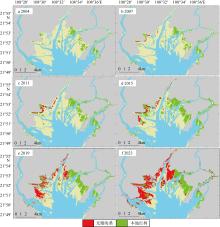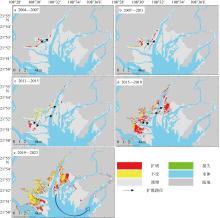| [1] |
常涛, 吴志强, 黄亮亮, 等, 2015. 茅尾海红树林水域仔稚鱼群落结构及与主要环境因子关系[J]. 应用海洋学学报, 34(2): 219-226.
|
|
CHANG TAO, WU ZHIQIANG, HUANG LIANGLIANG, et al, 2015. Community structures of fish larvae and its relation with environmental factors in the mangrove of Maoweihai Bay[J]. Journal of Applied Oceanography, 34(2): 219-226 (in Chinese with English abstract).
|
| [2] |
范航清, 2018. 红树林[M]. 南宁: 广西科学技术出版社 (in Chinese).
|
| [3] |
黄李丛, 苏宏河, 唐丰利, 2013. 钦州市引种无瓣海桑现状及发展对策分析[J]. 广东科技, 22(14): 188-189 (in Chinese).
|
| [4] |
亢振军, 郭伟, 李杰, 等, 2017. 茅岭江入海口水质状况分析与评价[J]. 海洋科学前沿, 4(1): 7-16.
|
|
KANG ZHENJUN, GUO WEI, LI JIE, et al, 2017. Water quality analysis and evaluation in Maolingjiang River inlet[J]. Advances in Marine Sciences, 4(1): 7-16 (in Chinese with English abstract).
doi: 10.12677/AMS.2017.41002
|
| [5] |
李云, 郑德璋, 陈焕雄, 等, 1998. 红树植物无瓣海桑引种的初步研究[J]. 林业科学研究, 11(1): 39-44.
|
|
LI YUN, ZHENG DEZHANG, CHEN HUANXIONG, et al, 1998. Preliminary study on introduction of mangrove Sonneratia apetala Buch-Ham[J]. Forest Research, 11(1): 39-44 (in Chinese with English abstract).
|
| [6] |
梁喜幸, 王日明, 戴志军, 等, 2023. 茅尾海钦江河口光滩时空变化过程研究[J]. 海洋地质与第四纪地质, 43(3): 107-118.
|
|
LIANG XIXING, WANG RIMING, DAI ZHIJUN, et al, 2023. Spatial-temporal variations of bare flats in the Qinjiang River estuary, Maowei Sea[J]. Marine Geology & Quaternary Geology, 43(3): 107-118 (in Chinese with English abstract).
|
| [7] |
廖宝文, 郑德璋, 郑松发, 等, 1997. 海桑育苗技术及其幼苗生长规律的研究[J]. 林业科学研究, 10(3): 296-302.
|
|
LIAO BAOWEN, ZHENG DEZHANG, ZHENG SONGFA, et al, 1997. The studies on seedling nursing techniques of Sonneratia carseolaris and its seedling growth rhythm[J]. Forest Research, 10(3): 296-302 (in Chinese with English abstract).
|
| [8] |
廖宝文, 李玫, 郑松发, 等, 2003. 外来种无瓣海桑种内、种间竞争关系研究[J]. 林业科学研究, 16(4): 418-422.
|
|
LIAO BAOWEN, LI MEI, ZHENG SONGFA, et al, 2003. Study on intraspecific and interspecific competition in exotic species Sonneratia apetala[J]. Forest Research, 16(4): 418-422 (in Chinese with English abstract).
|
| [9] |
蒙良莉, 凌子燕, 蒋卫国, 等, 2020. 基于Sentinel遥感数据的红树林信息提取研究——以广西茅尾海为例[J]. 地理与地理信息科学, 36(4): 41-47.
|
|
MENG LIANGLI, LING ZIYAN, JIANG WEIGUO, et al, 2020. Mangrove information extraction based on the sentinel remote sensing data: a case study of Maoweihai Bay of Guangxi[J]. Geography and Geo-Information Science, 36(4): 41-47 (in Chinese with English abstract).
|
| [10] |
王炳宇, 杨珊, 刘强, 等, 2020. 外来红树植物无瓣海桑和拉关木在海南东寨港的人工种植与自然扩散[J]. 生态学杂志, 39(6): 1778-1786.
|
|
WANG BINGYU, YANG SHAN, LIU QIANG, et al, 2020. Artificial planting and natural spread of exotic mangrove species Sonneratia apetala and Laguncularia racemosa in Dongzhai Harbor, Hainan[J]. Chinese Journal of Ecology, 39(6): 1778-1786 (in Chinese with English abstract).
|
| [11] |
王日明, 梁喜幸, 周晓妍, 等, 2022. 钦江河口潮滩红树林群落空间分布[J]. 遥感学报, 26(6): 1143-1154.
|
|
WANG RIMING, LIANG XIXING, ZHOU XIAOYAN, et al, 2022. Spatial distribution pattern of mangrove community in tidal flats of the Qinjiang Estuary[J]. National Remote Sensing Bulletin, 26(6): 1143-1154 (in Chinese with English abstract).
doi: 10.11834/jrs.20221540
|
| [12] |
王日明, 苏金恒, 戴志军, 等, 2025. 钦州湾茅岭江河口红树林湿地动态变化过程[J]. 热带海洋学报, 44(6):143-154.
|
|
WANG RIMING, SU JINHENG, DAI ZHIJUN, et al, 2025. Dynamic changes in mangrove wetland of the Maolingjiang Estuary, Qinzhou Gulf[J]. Journal of Tropical Oceanography, 44(6):143-154 (in Chinese with English abstract).
|
| [13] |
张坤, 娄安刚, 孟云, 等, 2014. 钦州湾海域纳潮量和水交换能力的数值模拟研究[J]. 海洋环境科学, 33(4): 585-591.
|
|
ZHANG KUN, LOU ANGANG, MENG YUN, et al, 2014. Numerical study on the tidal prism and water exchange ability of Qinzhou Bay[J]. Marine Environmental Science, 33(4): 585-591 (in Chinese with English abstract).
|
| [14] |
ADAME M F, NEIL D, WRIGHT S F, et al, 2010. Sedimentation within and among mangrove forests along a gradient of geomorphological settings[J]. Estuarine, Coastal and Shelf Science, 86(1): 21-30.
doi: 10.1016/j.ecss.2009.10.013
|
| [15] |
ALONGI D M, 2008. Mangrove forests: resilience, protection from tsunamis, and responses to global climate change[J]. Estuarine, Coastal and Shelf Science, 76(1): 1-13.
doi: 10.1016/j.ecss.2007.08.024
|
| [16] |
BARDOU R, FRIESS D A, GILLESPIE T W, et al, 2024. Assessing mangrove cover change in Madagascar (1972-2019): Widespread mangrove deforestation is slowing down[J]. Global Ecology and Conservation, 53: e03022.
doi: 10.1016/j.gecco.2024.e03022
|
| [17] |
CHANG C C, LIN C J, 2011. LIBSVM: a library for support vector machines[J]. ACM Transactions on Intelligent Systems and Technology, 2(3): 1-27.
|
| [18] |
CHEN L, PENG S, LI J, et al, 2013. Competitive control of an exotic mangrove species: restoration of native mangrove forests by altering light availability[J]. Restoration Ecology, 21(2): 215-223.
doi: 10.1111/rec.2013.21.issue-2
|
| [19] |
COHEN J, 1960. A coefficient of agreement for nominal scales[J]. Educational and Psychological Measurement, 20(1): 37-46.
doi: 10.1177/001316446002000104
|
| [20] |
DAI ZHIJUN, LONG CHUQI, MEI XUEFEI, et al, 2024. Overestimation of mangroves deterioration from sea level rise in tropical deltas[J]. Geophysical Research Letters, 51(19).
|
| [21] |
DONATO D C, KAUFFMAN J B, MURDIYARSO D, et al, 2011. Mangroves among the most carbon-rich forests in the tropics[J]. Nature Geoscience, 4(5): 293-297.
doi: 10.1038/ngeo1123
|
| [22] |
DUKE N C, MEYNECKE J O, DITTMANN S, et al, 2007. A world without mangroves?[J]. Science, 317(5834): 41-42.
doi: 10.1126/science.317.5834.41b
pmid: 17615322
|
| [23] |
FOURQUREAN J W, SMITH T J, POSSLEY J, et al, 2010. Are mangroves in the tropical Atlantic ripe for invasion? Exotic mangrove trees in the forests of South Florida[J]. Biological Invasions, 12(8): 2509-2522.
doi: 10.1007/s10530-009-9660-8
|
| [24] |
GIRI C, OCHIENG E, TIESZEN L L, et al, 2011. Status and distribution of mangrove forests of the world using earth observation satellite data[J]. Global Ecology and Biogeography, 20(1): 154-159.
doi: 10.1111/geb.2011.20.issue-1
|
| [25] |
GOLDBERG L, LAGOMASINO D, THOMAS N, et al, 2020. Global declines in human-driven mangrove loss[J]. Global Change Biology, 26(10): 5844-5855.
doi: 10.1111/gcb.v26.10
|
| [26] |
GORELICK N, HANCHER M, DIXON M, et al, 2017. Google Earth Engine: Planetary-scale geospatial analysis for everyone[J]. Remote Sensing of Environment, 202: 18-27.
doi: 10.1016/j.rse.2017.06.031
|
| [27] |
HAGGER V, WORTHINGTON T A, LOVELOCK C E, et al, 2022. Drivers of global mangrove loss and gain in social-ecological systems[J]. Nature Communications, 13: 6373.
doi: 10.1038/s41467-022-33962-x
pmid: 36289201
|
| [28] |
HAMILTON S, 2013. Assessing the role of commercial aquaculture in displacing mangrove forest[J]. Bulletin of Marine Science, 89(2): 585-601.
doi: 10.5343/bms.2012.1069
|
| [29] |
HAMILTON S, LOVETTE J, 2015. Ecuador’s mangrove forest carbon stocks: A spatiotemporal analysis of living carbon holdings and their depletion since the advent of commercial aquaculture[J]. Plos One, 10(3): e0118880.
doi: 10.1371/journal.pone.0118880
|
| [30] |
HAMILTON S, CASEY D, 2016. Creation of a high spatio‐temporal resolution global database of continuous mangrove forest cover for the 21st century (CGMFC‐21)[J]. Global Ecology and Biogeography, 25(6): 729-738.
doi: 10.1111/geb.2016.25.issue-6
|
| [31] |
HUETE A, DIDAN K, MIURA T, et al, 2002. Overview of the radiometric and biophysical performance of the MODIS vegetation indices[J]. Remote Sensing of Environment, 83(1/2): 195-213.
doi: 10.1016/S0034-4257(02)00096-2
|
| [32] |
LANDIS J R, KOCH G G, 1977. The measurement of observer agreement for categorical data[J]. Biometrics, 33(1): 159.
pmid: 843571
|
| [33] |
LOVELOCK C E, CAHOON D R, FRIESS D A, et al, 2015. The vulnerability of Indo-Pacific mangrove forests to sea-level rise[J]. Nature, 526(7574): 559-563.
doi: 10.1038/nature15538
|
| [34] |
MAZDA Y, MAGI M, IKEDA Y, et al, 2006. Wave reduction in a mangrove forest dominated by Sonneratia sp.[J]. Wetlands Ecology and Management, 14(4): 365-378.
doi: 10.1007/s11273-005-5388-0
|
| [35] |
MCFEETERS S K, 1996. The use of the Normalized Difference Water Index (NDWI) in the delineation of open water features[J]. International Journal of Remote Sensing, 17(7): 1425-1432.
doi: 10.1080/01431169608948714
|
| [36] |
RICHARDS D R, FRIESS D A, 2016. Rates and drivers of mangrove deforestation in Southeast Asia, 2000-2012[J]. PNAS, 113(2): 344-349.
doi: 10.1073/pnas.1510272113
pmid: 26712025
|
| [37] |
RICHARDS D R, THOMPSON B S, WIJEDASA L, 2020. Quantifying net loss of global mangrove carbon stocks from 20 years of land cover change[J]. Nature Communications, 11(1): 4260.
doi: 10.1038/s41467-020-18118-z
pmid: 32848150
|
| [38] |
REN H, LU H, SHEN W, et al, 2009. Sonneratia apetala Buch. Ham in the mangrove ecosystems of China: An invasive species or restoration species?[J]. Ecological Engineering, 35(8): 1243-1248.
doi: 10.1016/j.ecoleng.2009.05.008
|
| [39] |
ROUSE W J, HAAS H R, SCHELL J A, et al, 1974. Monitoring vegetation systems in the Great Plains with ERTS[J]. NASA Special Publication, 351(1): 309.
|
| [40] |
TAMIMINIA H, SALEHI B, MAHDIANPARI M, et al, 2020. Google Earth Engine for geo-big data applications: A meta-analysis and systematic review[J]. ISPRS Journal of Photogrammetry and Remote Sensing, 164: 152-170.
doi: 10.1016/j.isprsjprs.2020.04.001
|
| [41] |
ZHAO CHUANPENG, QIN CHENGZHI, WANG ZONGMING, et al, 2022. Decision surface optimization in mapping exotic mangrove species (Sonneratia apetala) across latitudinal coastal areas of China[J]. ISPRS Journal of Photogrammetry and Remote Sensing, 193: 269-283.
doi: 10.1016/j.isprsjprs.2022.09.011
|
 ), 李兴荣2, 王日明1, 戴志军3(
), 李兴荣2, 王日明1, 戴志军3( ), 龚受基4, 庞文鸿5, 张尚宇2
), 龚受基4, 庞文鸿5, 张尚宇2
 ), LI Xingrong2, WANG Riming1, DAI Zhijun3(
), LI Xingrong2, WANG Riming1, DAI Zhijun3( ), GONG Shouji4, PANG Wenhong5, ZHANG Shangyu2
), GONG Shouji4, PANG Wenhong5, ZHANG Shangyu2















